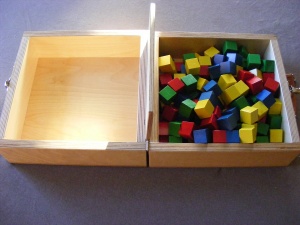How Do You Know if You Are Dexterious
Original Editor - Your proper name will be added here if you created the original content for this page.
Top Contributors - Lucinda hampton and Kim Jackson
Introduction [edit | edit source]

Dexterity refers to the power of a person to use the fingers, hands and arms to perform a task. The quality of functioning in daily living skills, piece of work-related operation, and recreational activities is determined to a large degree past hand part and transmission dexterity. The hand has to be able to undertake extremely fine and sensitive movements and must likewise be able to perform tasks requiring considerable force.[i][2]
A high degree of manual dexterity is a central feature of the human upper limb. A rich interplay of sensory and motor components in the paw and fingers allows for independent control of fingers in terms of timing, kinematics and strength.[iii]
Dexterity tests measure the accuracy of mitt and finger movements under controlled weather. They help physical therapists to develop rehabilitation plans for patients and to measure the effectiveness of their programs. They can assist identify and evaluate sure forms of brain harm, identify neurologically based learning disabilities, and musculoskeletal disabilities.
What are Different Types of Dexterity Tests? [edit | edit source]
Dexterity tests measure the accuracy of hand and finger movements under controlled conditions. At that place are several means to assess dexterity and coordination; A few examples are given below.
The 9-Hole Peg Exam (NHPT) is considered as a gilded standard measure of transmission dexterity and most frequently used clinical practice[4]
Purdue Peg Board Test, meet video below.
[v]
The Minnesota manual dexterity test involves having a person identify round pegs into holes on a punched out sheet. It evaluates their power to take hold of and place objects quickly. There are several different applications of this examination, including an assessment of limitations caused by carpal tunnel, and dexterity problems from other paw and wrist injuries.

The O'Connor finger dexterity examination evaluates fine motor skills by requiring the extensive use of finger tips to place pins into a peg board. Information technology is timed, so speed and accurateness are considered in the test scoring.
The box and block test uses cubes and focuses on picking up the cubes. Precise placement of the blocks is not required. Instead, they are dropped into a container that is shut to the container from which they are picked upward.
Why examination? - Research Findings [edit | edit source]
Listed below are examples of findings related to testing
- A rapid, nonlaboratory test of manual dexterity (eg the Purdue Pegboard Test) may assistance to identify persons at high risk for neurodegenerative diseases. This highlights the importance of motor function in the preclinical stage of both dementia and parkinsonism and may help in selecting individuals for refined screening and neuroprotective trials.[6]
- The NHPT is the optimal metric for measuring the impact of MS on upper extremity function. The majority of research suggests that a 20% change in test score is commonly used to define clinically meaningful worsening.[iv]
- Multiple aspects of sensorimotor control contribute to impaired manual dexterity in schizophrenia. Only visuomotor precision was related to antipsychotic medication. Skilful diagnostic accuracy and responsiveness to treatment suggest that manual dexterity may stand for a useful clinical marker in schizophrenia.[7]
- Manual dexterity measures can be useful for early detection of age-related functional decline and for prediction of cerebral decline.[eight]
Resources [edit | edit source]
References [edit | edit source]
- ↑ Carmeli Eastward, Patish H, Coleman R. The aging mitt. The Journals of Gerontology Series A: Biological Sciences and Medical Sciences. 2003 Feb 1;58(ii):M146-52. Available from:https://academic.oup.com/biomedgerontology/article/58/2/M146/593573 (last accessed 20.3.2020)
- ↑ Rehabmart Dexterity Tests Available from:https://world wide web.rehabmart.com/category/manipulation/dexterity_tests.htm#lesser (concluding accessed 20.iii.2020)
- ↑ Térémetz M, Colle F, Hamdoun S, Maier MA, Lindberg PG. A novel method for the quantification of key components of manual dexterity after stroke. Journal of neuroengineering and rehabilitation. 2015 Dec 1;12(1):64. Available from:https://www.ncbi.nlm.nih.gov/pubmed/26233571 (terminal accessed 20.3.2020)
- ↑ 4.0 4.1 Feys P, Lamers I, Francis G, Bridegroom R, Phillips G, LaRocca Due north, Hudson LD, Rudick R, Multiple Sclerosis Outcome Assessments Consortium. The Nine-Hole Peg Test every bit a manual dexterity performance measure for multiple sclerosis. Multiple Sclerosis Journal. 2017 Apr;23(v):711-xx. Available from:https://world wide web.ncbi.nlm.nih.gov/pmc/articles/PMC5405844/ (terminal accessed twenty.iii.2020)
- ↑ Dittrick PPBT Available from:https://www.youtube.com/spotter?v=xXT9E4OY9tw (last accessed 20.3.2020)
- ↑ Darweesh, S.Yard., Wolters, F.J., Hofman, A., Stricker, B.H., Koudstaal, P.J. and Ikram, 1000.A., 2017. Simple test of transmission dexterity can help to identify persons at high risk for neurodegenerative diseases in the community.Journals of Gerontology Series A: Biomedical Sciences and Medical Sciences,72(1), pp.75-81.https://bookish.oup.com/biomedgerontology/commodity/72/1/75/2629942 (last accessed 20.3.2020)
- ↑ Térémetz One thousand, Carment L, Brénugat-Herne L, Croca M, Bleton JP, Krebs MO, Maier MA, Amado I, Lindberg PG. Manual Dexterity in schizophrenia—a neglected clinical Marker?. Frontiers in psychiatry. 2017 Jul x;8:120. Available from:https://www.ncbi.nlm.nih.gov/pubmed/28740470 (last accessed 20.three.2020)
- ↑ Carment L, Abdellatif A, Lafuente-Lafuente C, Pariel S, Maier MA, Belmin J, Lindberg PG. Manual dexterity and crumbling: a pilot study disentangling sensorimotor from cerebral reject. Frontiers in neurology. 2018 Oct 29;ix:910.Available from:https://www.ncbi.nlm.nih.gov/pubmed/30420830 (last accessed 20.three.2020)
Source: https://www.physio-pedia.com/Dexterity_Tests
0 Response to "How Do You Know if You Are Dexterious"
Post a Comment